Homemade Gulkand Recipe (Rose Petal Preserve) with step-by-step photos and instructions.
With the summer peaking right now and the heat getting unbearable, Gulkand is the best health tonic to beat the heat during summers. Also, its cooling nature reduces body heat and improves metabolism.
During summers I prefer to have natural homemade cool drinks like fresh lime juice, fruit juices and my favourite Gulkand milk. I just love to have Gulkand milk which is very cool and refreshing. It is an ayurvedic medicine that has many health benefits. Learn how to make Gulkand at home using this traditional Gulkand rose recipe.
What is Gulkand?
Gulkand is a delicious sweet preserve made using fresh rose petals and sugar. It is believed that this rose preserves had originated from Indo-Persia and is widely produced in India and many other Asian countries. ‘Gul’ means flower in Persian and Urdu whereas ‘kand’ means sweet in Arabic. Rose Gulkand is a delectable sweet preserve and very easy to prepare.

Originally, Gulkand is prepared with Damask roses (also known as Damascus rose). The Damask rose possesses a strong sweet fragrance and hence it is used to make perfumes and the gulkand.
It blooms only in the summers and the autumn, thus making gulkand very exclusive. In fact, it was considered as a regal and opulent delicacy because of its seasonal nature and arduous cooking method.
However, now any variety of desi (native) roses are used to make this preserve. The roses should be organically grown and free from pesticides since they are being consumed.
A desi gulab (rose) will have a sweet fragrance. Always choose roses without blemishes and check for any insects. I have a lot of ‘gavthi’ rose plants in my garden (gavthi means local or desi in Konkani).
So whenever there are abundant roses blooming at a time I love to prepare this gulkand at home. The resultant quantity is very less (not more than a cup) but it is immensely gratifying.
Below you can see some of the desi roses from my garden..




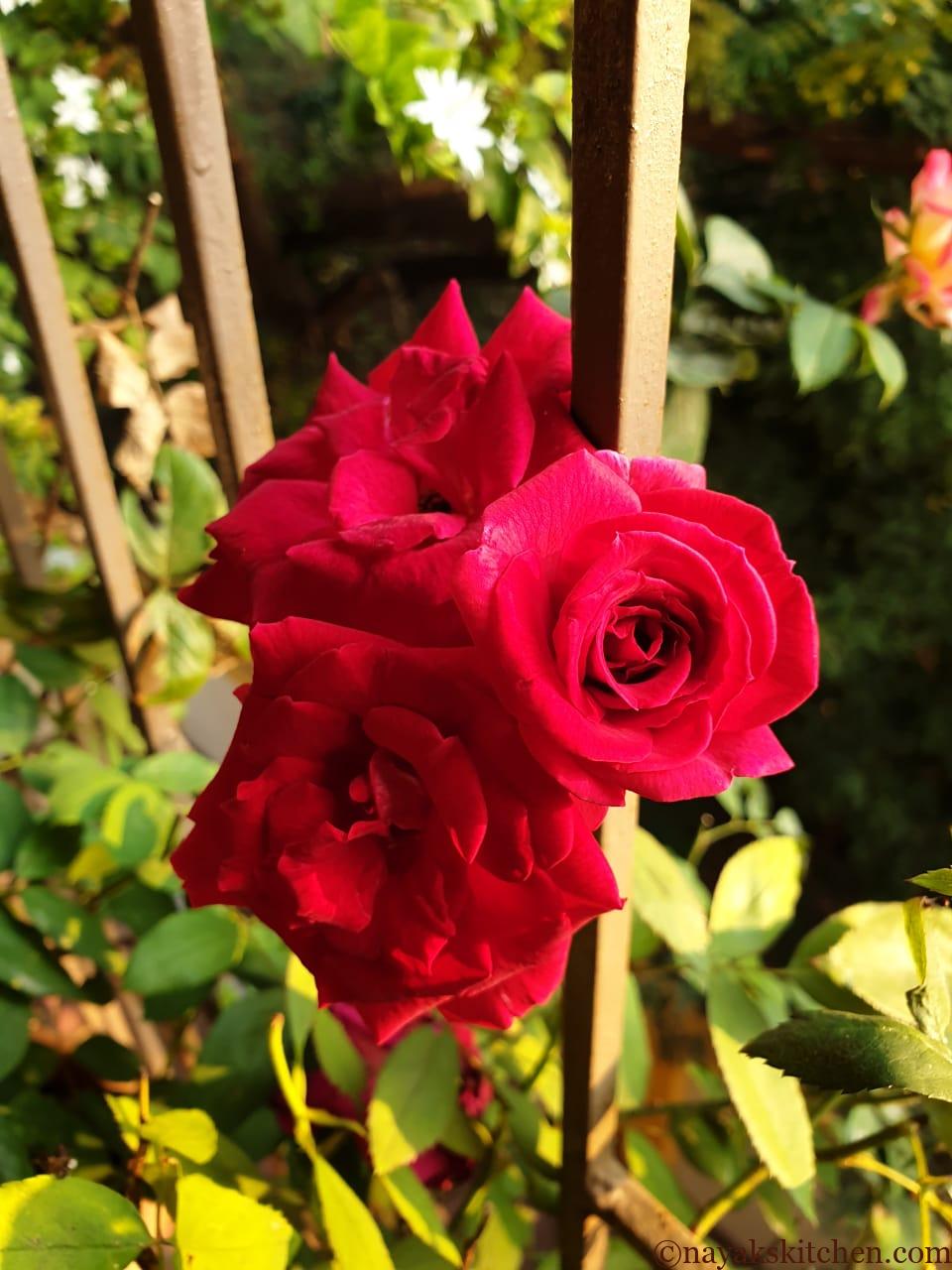
How is Gulkand prepared? (Gulkand Recipe)
The traditional method of making Gulkand is layering rose petals and sugar alternatively and sun-drying till everything blends well. That’s it. It is that simple! A ratio of 1:1 is used in the gulkand recipe, i.e. equal quantities of rose petals and sugar. Here sugar acts as a preservative though. However, I reduce the quantity of sugar to about half. You can also add fennel seeds (saunf/badishep).
The sun’s heat melts the sugar and evaporates any moisture in the layered petals and sugar. Also, the sun-cooking time varies as per the weather, season, climatic conditions of a particular region etc. The average time required is about a month. During summers Gulkand takes less than 15 days to get sun-cooked.
Gulkand gets better with the passage of time. It has a shelf life of about a year if stored properly. Always use a dry spoon to scoop out Gulkand and also store it in a clean, dry and airtight glass jar.
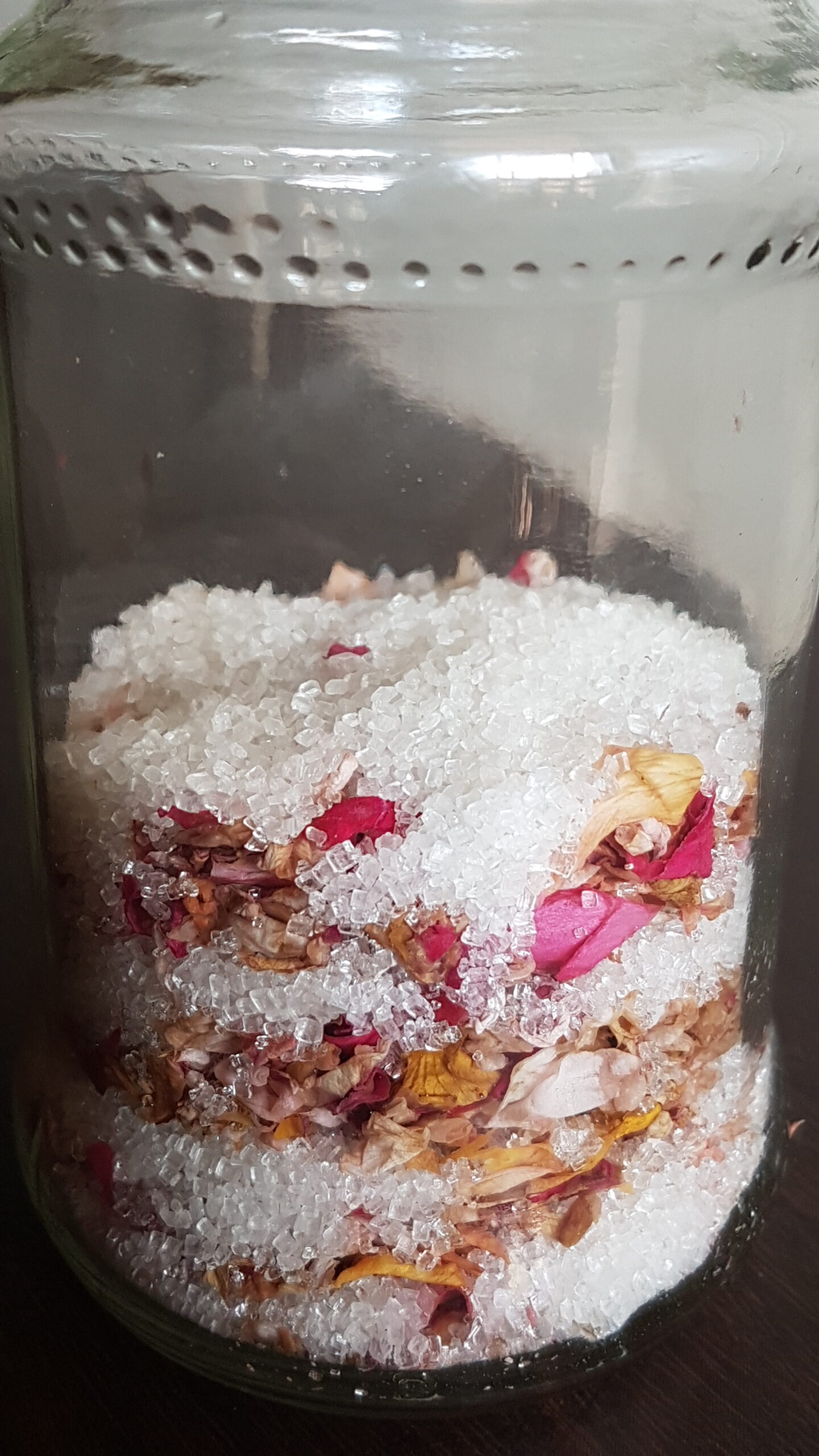

An alternate method of making Gulkand, adopted by some, is cooking the rose petals and sugar over the gas flame. This, though, gives you instant Gulkand, it will not give you the complete health benefits of the same. The sun-cooking method is a conventional and time-tested technique that conserves the nutrients in gulkand. Also, some of the recipes make use of jaggery or honey citing it as a healthy alternative. This too is inappropriate as traditionally Gulkand is prepared using sugar. However, diabetic people should consume it with precaution.
Health Benefits of Gulkand
Gulkand has innumerable benefits and it is used as a medicine in Ayurveda.
- The basic nature of Gulkand is its cooling nature. Hence, it protects from sunstroke in hot summers. Also it prevents sun-burns and nosebleeds caused due to heat.
- It reduces burning sensation in the body.
- It is good for acidity, heart burn and ulcers. Gulkand also purifies blood.
- Gulkand is a great immunity booster and is very nourishing.
- During summers when appetite takes a backseat, Gulkand is your best option. It improves appetite and aids digestion.
- Very good for muscular aches, lethargy and fatigue.
- Gulkand detoxifies the body and prevents acne.
- Also, it is extremely good for anaemic people.
- It has mild laxative properties. Hence, it is good for people having constipation.
- Improves eyesight and memory.
- It is useful if you have irregular periods and for hot flashes caused during menopause.
NOTE : Diabetic people should consult their doctor before consuming gulkand since it contains excess sugar.
How to use Gulkand?
Gulkand can be used in a variety of ways you can even imagine. The most basic is to directly have a spoonful. It is also used as a sweetener in desserts, milkshakes, lassis etc. Gulkand milk is the easiest drink to prepare. Just mix a teaspoon of Gulkand in a cup of milk. It tastes awesome if the milk is chilled.
It is used in making ‘paan’ which is eaten after meals. (Paan is an Indian mouth freshener that helps in digestion, especially heavy meals.)

A variety of desserts are given a twist by addition of the Gulkand. Just to name a few, Gulkand peda, ice-cream, rabri, rolls, kheer, gulab jamun etc. are relished with great fervour.
How to prepare Gulkand? (Gulkand Recipe)
- Choose roses that have no blemishes and insects.


2. Collect the fresh petals and discard the stalks.


3. Wash the petals with water a couple of times. Drain the water completely.
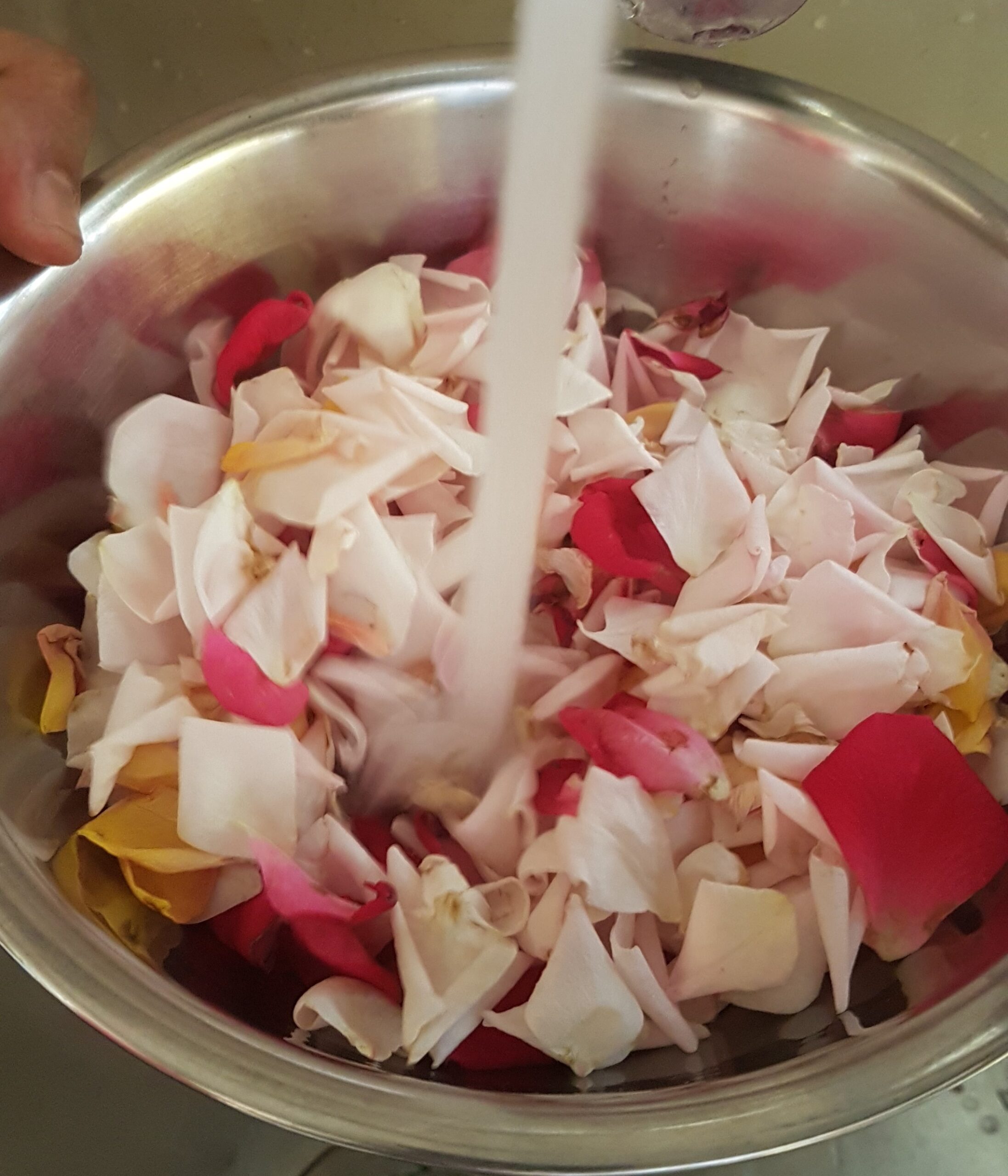
4. Dry the washed rose petals on a clean cloth. I have used a muslin cloth (malmal cloth) as the water on it dries up quickly.

5. Chop the petals roughly. You can also use the whole petals without chopping.


6. Take a clean and dry glass jar. Add an even layer of sugar in the jar. Next add a thin layer of rose petals. Keep repeating this step (alternating with rose petals and sugar) till all the rose petals are over.



7. Cover the glass jar with a lid and keep the jar in the sunlight for a minimum 6 hours daily for 3-4 weeks (about a month).
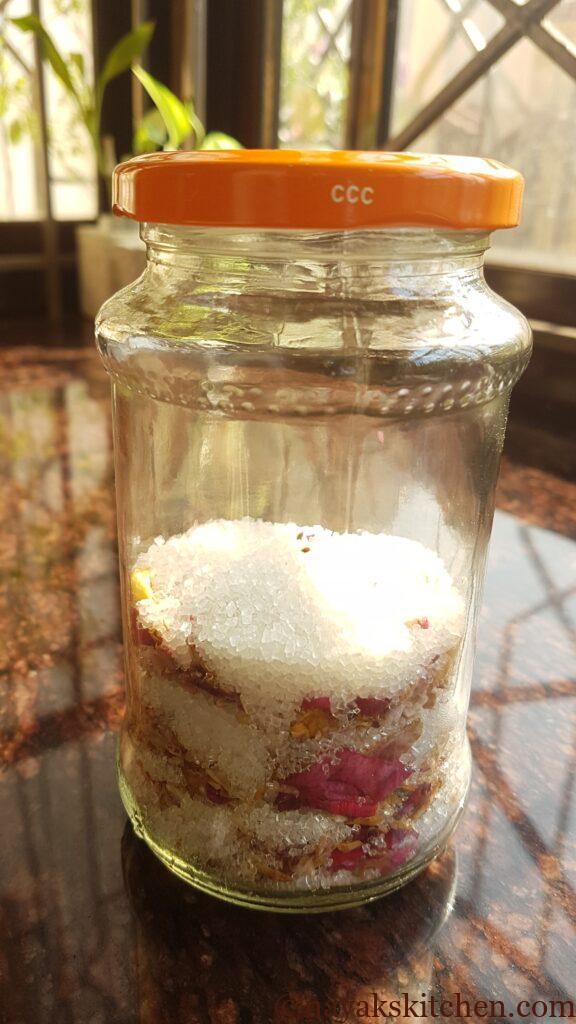
8. Mix the Gulkand every alternate day with a clean and dry spoon. After about a week you will see the petals and sugar have started blending with each other. The colour of the mixture will turn brown.



9. After about a month the rose petals and sugar will have combined well with each other. Your Gulkand is ready to eat!




Gulkand | How to make Gulkand at home | Rose Petal Preserve
Course: PreservesCuisine: IndianDifficulty: Very EasyGulkand is a sun-cooked sweet preserve made using fresh rose petals and sugar.
Ingredients
1 cup = 250 ml
Fresh Rose Petals – 2 cups (or as much as you have)
Sugar – as required (for layering)
Directions
- Choose roses that have no blemishes and insects. Collect the fresh petals and discard the stalks.
- Wash the petals with water a couple of times. Drain the water completely.
- Dry the washed rose petals on a clean cloth. I have used a muslin cloth as the water on it dries up quickly.
- Chop the petals roughly. You can also use the whole petals without chopping.
- Take a clean and dry glass jar. Add an even layer of sugar in the jar. Next add a thin layer of rose petals. Keep repeating this step (alternating with rose petals and sugar) till all the rose petals are over.
- Cover the glass jar with a lid and keep the jar in the sunlight for a minimum 6 hours daily for 3-4 weeks (about a month).
- Mix the Gulkand every alternate day with a clean and dry spoon. After about a week you will see the petals and sugar have started blending with each other.
- After about a month the rose petals and sugar will have combined well with each other. Your Gulkand is ready to eat!
Notes
- Always use desi organic roses which are pesticide free.
- Always use a glass jar to retain the nutrient value of Gulkand. Do not use plastic.
- You can add fennel seeds (saunf/badishep) while layering.
- The sun-cooking time varies as per the weather, season, climatic conditions of a particular region etc. Average time required is about a month.
- During summers Gulkand takes less than 15 days to get sun-cooked.
- Always use a clean and dry spoon to scoop gulkand.

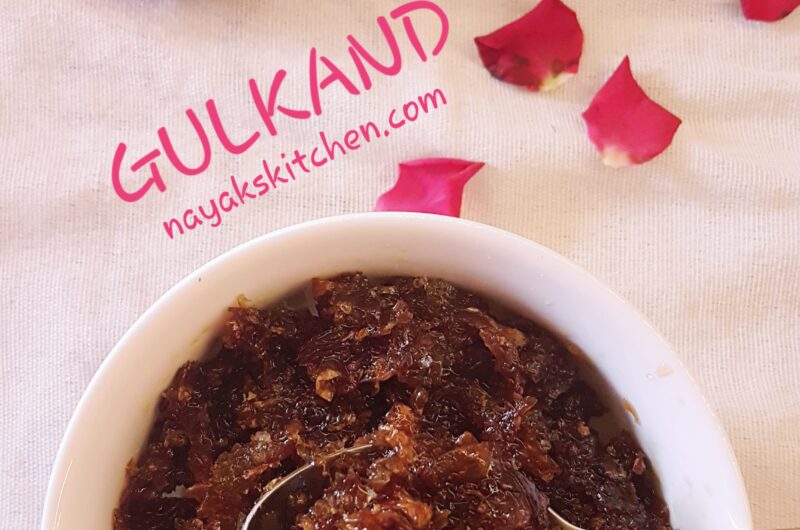



Yes you can!
Great recipe! Can this process be used with dried rose petals?
Very nicely explained